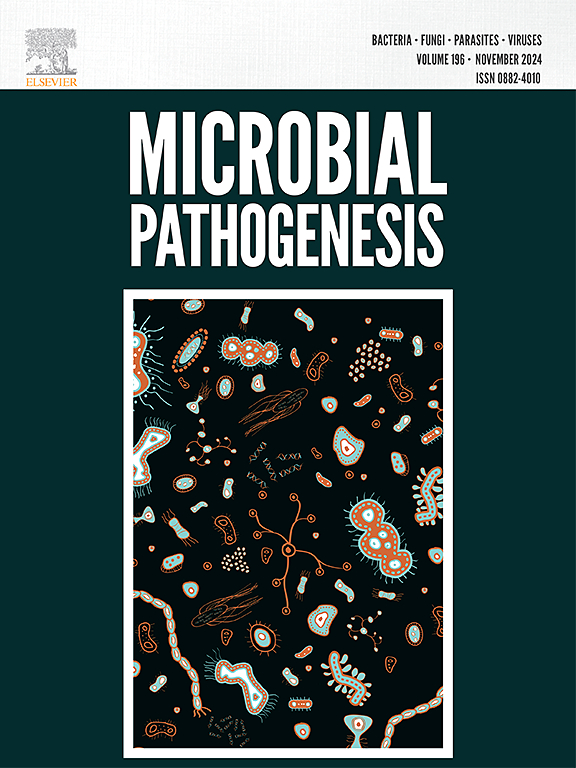Effect of novel non-coding small RNA111 of Pseudomonas aeruginosa on bacterial virulence
IF 3.5
3区 医学
Q3 IMMUNOLOGY
引用次数: 0
Abstract
Pseudomonas aeruginosa is an important gram-negative pathogen that often causes skin, respiratory, and bloodstream infections. The virulence of P. aeruginosa is regulated by sRNAs through a complex network, which is still incompletely understood. This study employed transcriptome sequencing (RNA-Seq) to screen sRNA 111, and real-time quantitative PCR was conducted for validation. In addition, an overexpression strain of sRNA111 was constructed and the effects of overexpression of sRNA111 on virulence factors such as biofilm formation, pyocyanin, swarming motility, inflammatory factors, and biofilm-associated factors were analyzed. The results revealed that sRNA111 might be closely related to the formation of P. aeruginosa biofilm. Compared to the vector, sRNA111 was found to enhance P. aeruginosa biofilm formation while also suppressing swarming motility, invasive ability, and adhesion capability. Meanwhile, sRNA111 up-regulated the expression of biofilm-related genes, such as Anr, pel family, polB, recA, etc., more significantly in the biofilm environment compared with the wild strain. In addition, sRNA111 effectively promoted the expression of inflammatory factors in the biofilm environment compared with the planktonic environment. These results implied that sRNA111 regulates the formation of P. aeruginosa biofilm and other virulence factors and further modulates the process of infection immunity.
铜绿假单胞菌的新型非编码小 RNA111 对细菌毒力的影响
铜绿假单胞菌是一种重要的革兰氏阴性病原体,经常引起皮肤、呼吸道和血液感染。铜绿假单胞菌的毒力受 sRNAs 的调控,其调控网络十分复杂,目前尚不完全清楚。本研究采用转录组测序(RNA-Seq)筛选出了 111 个 sRNA,并进行了实时定量 PCR 验证。此外,还构建了sRNA111的过表达菌株,并分析了过表达sRNA111对生物膜形成、脓蓝蛋白、蜂群运动、炎症因子和生物膜相关因子等毒力因子的影响。结果发现,sRNA111可能与铜绿微囊藻生物膜的形成密切相关。与载体相比,sRNA111在增强铜绿假单胞菌生物膜形成的同时,还抑制了铜绿假单胞菌的成群运动、侵袭能力和粘附能力。同时,与野生菌株相比,sRNA111 在生物膜环境中更显著地上调了生物膜相关基因的表达,如 Anr、pel 家族、polB、recA 等。此外,与浮游生物环境相比,sRNA111 能有效促进生物膜环境中炎性因子的表达。这些结果表明,sRNA111可调控铜绿微囊桿菌生物膜的形成及其他毒力因子,并进一步调节感染免疫过程。
本文章由计算机程序翻译,如有差异,请以英文原文为准。
求助全文
约1分钟内获得全文
求助全文
来源期刊

Microbial pathogenesis
医学-免疫学
CiteScore
7.40
自引率
2.60%
发文量
472
审稿时长
56 days
期刊介绍:
Microbial Pathogenesis publishes original contributions and reviews about the molecular and cellular mechanisms of infectious diseases. It covers microbiology, host-pathogen interaction and immunology related to infectious agents, including bacteria, fungi, viruses and protozoa. It also accepts papers in the field of clinical microbiology, with the exception of case reports.
Research Areas Include:
-Pathogenesis
-Virulence factors
-Host susceptibility or resistance
-Immune mechanisms
-Identification, cloning and sequencing of relevant genes
-Genetic studies
-Viruses, prokaryotic organisms and protozoa
-Microbiota
-Systems biology related to infectious diseases
-Targets for vaccine design (pre-clinical studies)
 求助内容:
求助内容: 应助结果提醒方式:
应助结果提醒方式:


